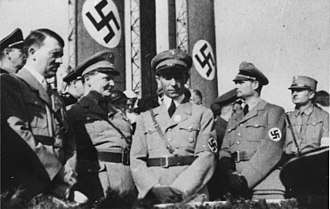Sturmabteilung
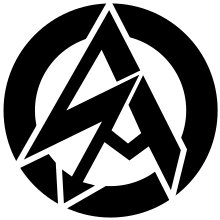 SA insignia | |
 Adolf Hitler and Ernst Röhm inspecting the SA in Nuremberg in 1933 | |
| Agency overview | |
|---|---|
| Formed | 1920 |
| Dissolved | May 8, 1945 |
| Superseding agency |
|
| Type | Paramilitary |
| Jurisdiction | |
| Headquarters |
SA High Command, Barerstraße, Munich 48°8′37.53″N 11°34′6.76″E / 48.1437583°N 11.5685444°E |
| Minister responsible |
|
| Parent agency | Nazi Party (NSDAP) |
| Child agency |
|
The Sturmabteilung (SA; German pronunciation: [ˈʃtʊɐ̯mʔapˌtaɪlʊŋ] (![]()
The SA were also called the "Brownshirts" (Braunhemden) from the color of their uniform shirts, similar to Benito Mussolini's blackshirts. The SA developed pseudo-military titles for its members, with ranks that were later adopted by several other Nazi Party groups, chief amongst them the Schutzstaffel (SS), which originated as a branch of the SA before being separated. Brown-colored shirts were chosen as the SA uniform because a large number of them were cheaply available after World War I, having originally been ordered during the war for colonial troops posted to Germany's former African colonies.[1]
The SA became disempowered after Adolf Hitler ordered the "blood purge" of 1934. This event became known as the Night of the Long Knives (die Nacht der langen Messer). The SA continued to exist, but was effectively superseded by the SS, although it was not formally dissolved until after Nazi Germany's final capitulation to the Allies in 1945.
Rise
The term Sturmabteilung predates the founding of the Nazi Party in 1919. Originally it was applied to the specialized assault troops of Imperial Germany in World War I who used Hutier infiltration tactics. Instead of large mass assaults, the Sturmabteilung were organised into small squads of a few soldiers each. The first official German Stormtrooper unit was authorized on 2 March 1915. The German high command ordered the VIII Corps to form a detachment to test experimental weapons and develop tactics that could break the deadlock on the Western Front. On 2 October 1916, Generalquartiermeister Erich Ludendorff ordered all German armies in the west to form a battalion of stormtroops.[2] They were first used during the 8th Army's siege of Riga, and again at the Battle of Caporetto. Wider use followed on the Western Front in the Spring Offensive in March 1918, where Allied lines were successfully pushed back tens of kilometers.
The DAP (Deutsche Arbeiterpartei, German Workers' Party) was formed in Munich in January 1919 and Adolf Hitler joined it in September of that year. His talents for speaking, publicity and propaganda were quickly recognized,[3] and by early 1920 he had gained authority in the party, which changed its name to the NSDAP (Nationalsozialistische Deutsche Arbeiterpartei or National Socialist German Workers' Party) in February 1920,[4] although "Socialist" was added by the party's executive committee, over Hitler's objections, to help the party appeal to left-wing workers.[5]
The precursor to the Sturmabteilung had acted informally and on an ad hoc basis for some time before this. Hitler, with an eye always to helping the party to grow through propaganda, convinced the leadership committee to invest in an advertisement in the Münchener Beobachter (later renamed the Völkischer Beobachter) for a mass meeting in the Hofbräuhaus, to be held on 16 October 1919. Some 70 people attended, and a second such meeting was advertised for 13 November in the Eberl-Bräu beer hall. About 130 people attended; there were hecklers, but Hitler's military friends promptly ejected them by force, and the agitators "flew down the stairs with gashed heads." The next year, on 24 February, he announced the party's Twenty-Five Point program at a mass meeting of some 2,000 people at the Hofbräuhaus. Protesters tried to shout Hitler down, but his former army companions, armed with rubber truncheons, ejected the dissenters. The basis for the SA had been formed.[6]
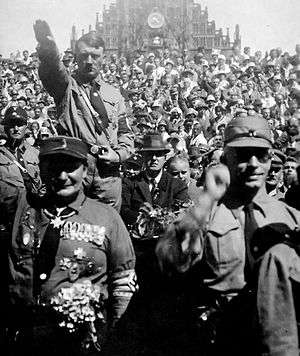
A permanent group of party members who would serve as the Saalschutzabteilung (meeting hall protection detachment) for the DAP gathered around Emil Maurice after the February 1920 incident at the Hofbräuhaus. There was little organization or structure to this group. The group was also called the Ordnertruppen around this time.[7] More than a year later, on 3 August 1921, Hitler redefined the group as the "Gymnastic and Sports Division" of the party (Turn- und Sportabteilung), perhaps to avoid trouble with the government.[8] It was by now well recognized as an appropriate, even necessary, function or organ of the party. The future SA developed by organizing and formalizing the groups of ex-soldiers and beer hall brawlers who were to protect gatherings of the Nazi Party from disruptions from Social Democrats (SPD) and Communists (KPD) and to disrupt meetings of the other political parties. By September 1921 the name Sturmabteilung (SA) was being used informally for the group.[9] Hitler was the official head of the Nazi Party by this time.[10]
The Nazi Party held a large public meeting in the Munich Hofbräuhaus on 4 November 1921, which also attracted many Communists and other enemies of the Nazis. After Hitler had spoken for some time, the meeting erupted into a mêlée in which a small company of SA thrashed the opposition. The Nazis called this event the Saalschlacht ("meeting hall battle"), and it assumed legendary proportions in SA lore with the passage of time. Thereafter, the group was officially known as the Sturmabteilung.[9]
The leadership of the SA passed from Maurice to the young Hans Ulrich Klintzsch in this period. He had been a naval officer and a member of the Erhardy Brigade of Kapp Putsch fame, and was, at the time of his assumption of SA command, a member of the notorious Organisation Consul (OC).[11] The Nazis under Hitler were taking advantage of the more professional management techniques of the military.[9]
In 1922, the Nazi Party created a youth section, the Jugendbund, for young men between the ages of 14 and 18 years. Its successor, the Hitler Youth (Hitlerjugend or HJ), remained under SA command until May 1932. Hermann Göring joined the Nazi Party in 1922 after hearing a speech by Hitler. He was given command of the SA as the Oberster SA-Führer in 1923. He was later appointed an SA-Gruppenführer (lieutenant general) and held this rank on the SA rolls until 1945.
From April 1924 until late February 1925 the SA was reorganized into a front organization known as the Frontbann to circumvent Bavaria's ban on the Nazi Party and its organs (instituted after the abortive Beer Hall putsch of November 1923). While Hitler was in prison, Ernst Röhm helped to create the Frontbann as a legal alternative to the then-outlawed SA. At Landsberg prison in April 1924, Röhm had also been given authority by Hitler to rebuild the SA in any way he saw fit. When in April 1925 Hitler and Ludendorff disapproved of the proposals under which Röhm was prepared to integrate the 30,000-strong Frontbann into the SA, Röhm resigned from all political movements and military brigades on 1 May 1925 and sought seclusion from public life. Members of the SA were, throughout the 1920s and into the 1930s, often involved in street fights called Zusammenstöße (collisions) with members of the Communist Party (KPD). In 1929, the SA added a Motor Corps for better mobility and a faster mustering of units.[12]
In September 1930, as a consequence of the Stennes Revolt in Berlin, Hitler assumed supreme command of the SA as its new Oberster SA-Führer. He sent a personal request to Röhm, asking him to return to serve as the SA's chief of staff. Röhm accepted this offer and began his new assignment on 5 January 1931. He brought radical new ideas to the SA, and appointed several close friends to its senior leadership. Previously, the SA formations were subordinate to the Nazi Party leadership of each Gau. Röhm established new Gruppen which had no regional Nazi Party oversight. Each Gruppe extended over several regions and was commanded by a SA Gruppenführer who answered only to Röhm or Hitler. Under Röhm as its popular leader and Stabschef (Staff Chief), the SA grew in importance within the Nazi power structure, growing to thousands of members. In the early 1930s, the Nazis expanded from an extremist fringe group to the largest political party in Germany, and the SA expanded with it. By January 1932, the SA numbered approximately 400,000 men.[13]
Many of these stormtroopers believed in the socialist promise of National Socialism and expected the Nazi regime to take more radical economic action, such as breaking up the vast landed estates of the aristocracy once they obtained national power.[14] By the time Hitler assumed power in January 1933, SA membership had increased to approximately 2,000,000—twenty times larger than the Reichswehr (German Army).[15]
Fall
After Hitler and the Nazis obtained national power, the SA became increasingly eager for power itself. By the end of 1933, the SA numbered over three million men and many saw themselves as a replacement for the "antiquated" Reichswehr. Röhm's ideal was to absorb the army (then limited by law to no more than 100,000 men) into the SA, which would be a new "people's army". This deeply offended and alarmed the army, and threatened Hitler's goal of co-opting the Reichswehr. The SA's increasing power and ambitions also posed a threat to the other Nazi leaders.[16] Originally an adjunct to the SA, the Schutzstaffel (SS) was placed under the control of Heinrich Himmler in part to restrict the power of the SA and their leaders.[17] The younger SS had evolved to be more than a bodyguard unit for Hitler and showed itself better suited to carry out Hitler's policies, including those of a criminal nature.[18][19]
Although some of these conflicts were based on personal rivalries, there were also key socio-economic conflicts between the SS and SA. SS members generally came from the middle class, while the SA had its base among the unemployed and working class. Politically speaking, the SA were more radical than the SS, with its leaders arguing the Nazi revolution had not ended when Hitler achieved power, but rather needed to implement socialism in Germany (see Strasserism). Furthermore, the defiant and rebellious culture encouraged before the seizure of power had to give way to a community organization approach such as canvassing and fundraising, which the SA resented as Kleinarbeit ("little work"), normally performed by women before the seizure of power.[20] Rudolf Diels, the first Gestapo chief, estimated in 1933 Berlin that 70 percent of new SA recruits were former Communists.[21]
In 1933, General Werner von Blomberg, the Minister of Defence, and General Walther von Reichenau, the chief of the Reichswehr's Ministerial Department, became increasingly concerned about the growing power of the SA. Röhm had been given a seat on the National Defence Council and began to demand more say over military matters. On 2 October 1933, Röhm sent a letter to Reichenau that said: "I regard the Reichswehr now only as a training school for the German people. The conduct of war, and therefore of mobilization as well, in the future is the task of the SA."[22]
Blomberg and von Reichenau began to conspire with Göring and Himmler against Röhm and the SA. Himmler asked Reinhard Heydrich to assemble a dossier on Röhm. Heydrich recognized that for the SS to gain full national power the SA had to be broken.[23] He manufactured evidence that suggested that Röhm had been paid 12 million marks by French agents to overthrow Hitler. Hitler liked Röhm and initially refused to believe the dossier provided by Heydrich. Röhm had been one of his first supporters and, without his ability to obtain army funds in the early days of the movement, it is unlikely that the Nazis would have ever become established. The SA under Röhm's leadership had also played a vital role in destroying the opposition during the elections of 1932 and 1933.
Night of the Long Knives
Hitler had his own reasons for wanting Röhm removed. Powerful supporters of Hitler had been complaining about Röhm for some time. The generals opposed Röhm's desire to have the SA, a force of over three million men, absorb the much smaller German Army into its ranks under his leadership;[23] having built the Reichswehr into a professional force of 100,000, they believed that it would be destroyed if merged with millions of untrained SA thugs.[24] Furthermore, reports of a huge cache of weapons in the hands of SA members gave the army commanders even more concern.[23] Industrialists, who had provided the funds for the Nazi victory, were unhappy with Röhm's socialistic views on the economy and his claims that the real revolution had still to take place. President Hindenburg informed Hitler in June 1934 that if a move to curb the SA was not forthcoming, then he would dissolve the government and declare martial law.[25]
Hitler was also concerned that Röhm and the SA had the power to remove him as leader. Göring and Himmler played on this fear by constantly feeding him with new information on Röhm's proposed coup. A masterstroke was to claim that Gregor Strasser, whom Hitler hated, was part of the planned conspiracy against him. With this news Hitler ordered all the SA leaders to attend a meeting in the Hanselbauer Hotel[26] in Bad Wiessee.
On 30 June 1934, Hitler, accompanied by SS units, arrived at Bad Wiessee, where he personally placed Röhm and other high-ranking SA leaders under arrest. Over the next 48 hours, 200 other senior SA officers were arrested on the way to Wiessee. Many were shot as soon as they were captured, but Hitler decided to pardon Röhm because of his past services to the movement. On 1 July, after much pressure from Göring and Himmler, Hitler agreed that Röhm should die. Hitler insisted that Röhm should first be allowed to commit suicide. However, when Röhm refused, he was killed by two SS officers, Theodor Eicke and Michael Lippert.[27] The names of 85 victims are known; however, estimates place the total number killed at between 150 and 200 people.[28] While some Germans were shocked by the killing, many others saw Hitler as the one who restored "order" to the country. Goebbels's propaganda highlighted the "Röhm-Putsch" in the days that followed. The homosexuality of Röhm and other SA leaders was made public to add "shock value", even though the sexuality of Röhm and other named SA leaders had been known by Hitler and other Nazi leaders for years.[29]
After the purge
After the Night of the Long Knives, the SA continued to exist under the leadership of Viktor Lutze, but the group was significantly downsized. Within a year's time the SA membership was reduced over 40% in size.[28] However, attacks against the Jews escalated in the late 1930s and the SA was a main perpetrator of the actions.
In November 1938, after the murder of German diplomat Ernst vom Rath by Herschel Grynszpan (a Polish Jew), the SA were used for "demonstrations" against the act. In violent riots, members of the SA shattered the glass storefronts of about 7,500 Jewish stores and businesses, hence the name Kristallnacht (Crystal Night) given to the events.[30] Jewish homes were ransacked throughout Germany. This pogrom damaged, and in many cases destroyed, about 200 synagogues (constituting nearly all Germany had), many Jewish cemeteries, more than 7,000 Jewish shops, and 29 department stores. Some Jews were beaten to death and more than 30,000 Jewish men were arrested and taken to concentration camps.[31]
Thereafter, the SA became overshadowed by the SS, and by 1939 had little remaining significance in the Nazi Party. In January 1939, the role of the SA was officially established as a training school for the armed forces with the establishment of the SA Wehrmannschaften (SA Military Units).[32] With the start of World War II in September 1939, the SA lost most of its remaining members to military service in the Wehrmacht (armed forces).[33] Later, an attempt was made to form an SA combat division on similar lines to the Waffen-SS, the result being the creation of the Feldherrnhalle SA-Panzergrenadier Division.
In 1943, Viktor Lutze was killed in an automobile accident and leadership of the SA was assumed by Wilhelm Schepmann.[34] Schepmann did his best to run the SA for the remainder of the war, attempting to restore the group as a predominant force within the Nazi Party and to mend years of distrust and bad feelings between the SA and SS.
The SA officially ceased to exist in May 1945 when Nazi Germany collapsed. The SA was banned by the Allied Control Council shortly after Germany's capitulation. In 1946, the International Military Tribunal at Nuremberg formally judged the SA not to be a criminal organization.[35]
In the modern age, several Neo-Nazi groups claim they are continued extensions of the SA, with terms such as "stormtrooper" and "brownshirt" common in Neo-Nazi vocabulary, though these groups are often loosely organized with separate agendas.
Leaders
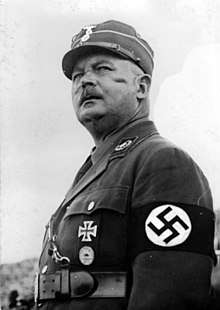
The leader of the SA was known as the Oberster SA-Führer, translated as Supreme SA-Leader. The following men held this position:
- Emil Maurice (1920–1921)[36]
- Hans Ulrich Klintzsche (1921–1923)
- Hermann Göring (1923)
- None (1923–1925)[37]
- Franz Pfeffer von Salomon (1926–1930)[38]
- Adolf Hitler (1930–1945)[38]
In September 1930, to quell the Stennes Revolt and to try to ensure the personal loyalty of the SA to himself, Hitler assumed command of the entire organization and remained Oberster SA-Führer for the remainder of the group's existence until 1945. The day-to-day running of the SA was conducted by the Stabschef-SA (SA Chief of Staff); a position Hitler designated for Ernst Röhm.[39] After Hitler's assumption of the supreme command of the SA, it was the Stabschef-SA who was generally accepted as the Commander of the SA, acting in Hitler's name. The following personnel held the position of Stabschef-SA:
- Otto Wagener (1929–1931)
- Ernst Röhm (1931–1934)
- Viktor Lutze (1934–1943)
- Wilhelm Schepmann (1943–1945)
Organization
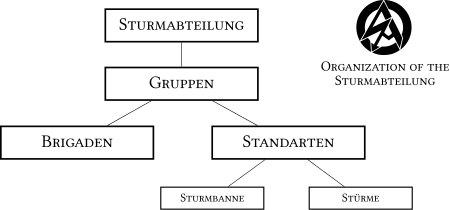
The SA was organized into several large regional Gruppen ("Groups"). Each Gruppe had subordinate Brigaden ("Brigades"). Subordinate to the Brigaden were the smaller regiment-sized Standarten. SA-Standarten operated in every major German city and were split into even smaller units, known as Sturmbanne and Stürme.
The command nexus for the entire SA was the Oberste SA-Führung, located in Stuttgart. The SA supreme command had many sub-offices to handle supply, finance, and recruiting. Unlike the SS, however, the SA did not have a medical corps nor did it establish itself outside of Germany, in occupied territories, once World War II had begun.
The SA also had several military training units. The largest was the SA-Marine, which served as an auxiliary to the Kriegsmarine (German Navy) and performed search and rescue operations as well as harbor defense. The SA also had an "army" wing, similar to the Waffen-SS, known as Feldherrnhalle. This formation expanded from regimental size in 1940 to a fully-fledged armored corps (Panzerkorps Feldherrnhalle) in 1945.
Organization structure August 1934–1945
- Oberste SA-Führung (Supreme SA-Command & Control)
- Gruppe (Group): consisting of several brigades[40]
- Brigade: 3 to 9 Standarten (Standards)
- Standarte (Standard, regiment sized unit): 3 to 5 Sturmbanne (Storm banns)
- Sturmbann (Storm bann, battalion sized unit): 3 to 5 Stürme (Storms)
- Sturm (Storm, company sized sub-unit): 3 to 4 Trupps (platoons)
- Trupp (Troupe, platoon sized sub-unit): 3 to 4 Scharen (sections)
- Schar (section): 1 to 2 Rotten (squads or teams)
- Rotte (squad or team): 4 to 8 SA-Men/SA-Troopers
- SA-Mann (SA-Man/SA-Trooper)
"Beefsteaks" within the ranks
In his 1936 Hitler: A Biography, German historian Konrad Heiden remarked that within the SA ranks, there were "large numbers of Communists and Social Democrats" and that "many of the storm troops were called 'beefsteaks' – brown outside and red within."[41] The influx of non-Nazis into the Sturmabteilung membership was so prevalent that SA men would joke that "In our storm troop there are three Nazis, but we shall soon have spewed them out."[41]
The number of 'beefsteaks' was estimated to be large in some cities, especially in northern Germany, where the influence of Gregor Strasser and Strasserism was significant.[42] The head of the Gestapo from 1933 to 1934, Rudolf Diels, reported that "70 percent" of the new SA recruits in the city of Berlin had been communists.[43] Other historians contend that the SA and SS were awash with Marxists and socialist revolutionaries, where "The utopians and those who speak of a Marxist republic have the highest membership in the SA and SS (77.6 and 63 percent respectively)."[44]
Some have argued that since most SA members came from working-class families or were unemployed, they were more amenable to Marxist-leaning socialism, expecting Hitler to fulfill the 25-point National Socialist Program.[45] However, historian Thomas Friedrich reports that the repeated efforts by the Communist Party of Germany (KPD) to appeal to the working-class backgrounds of the SA were "doomed to failure", because most SA men were focused on the cult of Hitler and destroying the "Marxist enemy".[46]
The "beefsteak" name also referred to party-switching between Nazi and Communist party members, particularly involving those within the SA ranks.
See also
- Uniforms and insignia of the Sturmabteilung ⇒ Corps colours of the Sturmabteilung
- Militia
- Political color
- Political uniform
- Glossary of Nazi Germany
- List of Nazi Party leaders and officials
- National Action – Neo-nazi organisation which uses logo based on SA
Similar paramilitary organisations
- Albanian Fascist Party – Albania ("Blackshirts")
- Black Brigades
- Blackshirts - Italy
- British Union of Fascists – United Kingdom ("Blackshirts")
- Blue Shirts Society – Republic of China and Taiwan (Kuomintang)
- Blueshirts – Ireland
- Black Shorts – parody of the blackshirts in the writings of P. G. Wodehouse
- Freikorps - independent paramilitary organizations of ex-German Army soldiers and unemployed workers who fought against Communist uprisings after World War I
- Greenshirts (National Corporate Party) – Ireland
- Gold shirts – Mexico
- Greyshirts – ethnically Dutch South Africans (Afrikaaners)
- Hirden – paramilitary wing of the NS, the Norwegian National Socialist party 1940–45.
- Integralismo
- Iron Guard – Romania ("Greenshirts")
- Italian Social Republic – ("Blackshirts")
- Militia organizations in the United States
- National Socialist Motor Corps - another Nazi Party organization
- Parti national social chrétien – Canada ("Blueshirts")
- Portuguese Legion (Estado Novo) – Portugal
- Silver Legion of America – United States ("Silvershirts")
- Squadrismo
- Tatenokai
- Weimar paramilitary groups
- Yokusan Sonendan
References
Notes
- ↑ Toland p. 220
- ↑ Drury, Ian (2003). German Stormtrooper 1914–1918. Osprey Publishing.
- ↑ Before the end of 1919, Hitler had already been appointed head of propaganda for the party, with party founder Anton Drexler's backing. Toland p. 94.
- ↑ Kershaw 2008, p. 87.
- ↑ Mitcham 1996, p. 68.
- ↑ Toland pp. 94–98
- ↑ See Manchester p. 342.
- ↑ William L. Shirer, The Rise and Fall of the Third Reich (1960) p. 42; Toland p. 112
- 1 2 3 Campbell pp. 19–20
- ↑ At a special party congress held 29 July 1921, Hitler was appointed chairman. He announced that the party would stay headquartered in Munich and that those who did not like his leadership should just leave; he would not entertain debate on such matters. The vote was 543 for Hitler, and 1 against him. Toland p. 111.
- ↑ The OC's most infamous action was probably the brazen daylight assassination of foreign minister Walther Rathenau, in early 1922. Klintzsch was also a member of the somewhat more reputable Viking League (Bund Wiking).
- ↑ McNab 2013, p. 14.
- ↑ McNab 2011, p. 142.
- ↑ Bullock 1958, p. 80.
- ↑ "SA". Encyclopædia Britannica. Retrieved 2017-07-28.
- ↑ Kershaw 2008, pp. 304–306.
- ↑ McNab 2009, pp. 17, 19–21.
- ↑ Baranowski 2010, pp. 196–197.
- ↑ Kershaw 2008, pp. 309–314.
- ↑ Claudia Koonz, The Nazi Conscience, p. 87
- ↑ Timothy S. Brown. Weimar Radicals: Nazis and Communists between Authenticity and Performance. p. 136.
- ↑ Alford, Kenneth (2002). Nazi Millionaires: The Allied Search for Hidden SS Gold. p. 5. ISBN 978-0-9711709-6-4.
- 1 2 3 Kershaw 2008, p. 306.
- ↑ Gunther, John (1940). Inside Europe. New York: Harper & Brothers. pp. 53–54.
- ↑ Wheeler-Bennett 2005, pp. 319–320.
- ↑ "Hotel Hanslbauer in Bad Wiessee: Scene of the Arrest of Ernst Röhm and his Followers (June 30, 1934) – Image". ghi-dc.org.
- ↑ Kershaw 2008, pp. 309–312.
- 1 2 Kershaw 2008, p. 313.
- ↑ Kershaw 2008, p. 315.
- ↑ GermanNotes, "Archived copy". Archived from the original on 2005-04-19. Retrieved 2009-03-06. , retrieved 11/26/2007
- ↑ The deportation of Regensburg Jews to Dachau concentration camp (Yad Vashem Photo Archives 57659)
- ↑ McNab 2013, pp. 20, 21.
- ↑ McNab 2009, p. 22.
- ↑ McNab 2013, p. 21.
- ↑ "The Sturmabteilung or SA". History Learning Site. Retrieved 22 September 2013.
- ↑ Hoffmann 2000, p. 50.
- ↑ The NSDAP and its organs and instruments (including the Völkischer Beobachter and the SA) were banned in Bavaria (and other parts of Germany) following Hitler's abortive attempt to overthrow the Weimar Republic in the Beer Hall Putsch in November 1923. The Bavarian ban was lifted in February 1925 after Hitler pledged to adhere to legal and constitutional means in his quest for political power. See Verbotzeit.
- 1 2 Yerger 1997, p. 11.
- ↑ Yerger 1997, pp. 11, 12.
- ↑ The SA-Brigade was also designated as SA-Untergruppe (SA-Subgroup). (David Littlejohn: The SA 1921–45, p. 7)
- 1 2 Heiden, Konrad (1938). Hitler: A Biography. London: Constable & Co. Ltd. p. 390.
- ↑ Mitcham 1996, p. 120.
- ↑ Brown, Timothy S. Brown (2009) Weimar Radicals: Nazis and Communists Between Authenticity and Performance, New York: Berghahn Books. p.136
- ↑ Merkl, Peter H. (1975) Political Violence Under the Swastika: 581 Early Nazis, Princeton, New Jersey: Princeton University Press. p.484
- ↑ Bendersky, Joseph W. (2007) A Concise History of Nazi Germany Lanham, Maryland: Rowman & Littlefield. p.96
- ↑ Friedrich, Thomas (2012). Hitler's Berlin: Abused City. Translated by Spencer, Stewart. New Haven, Connecticut: Yale University Press. pp. 213 and 215. ISBN 978-0-300-16670-5.
Bibliography
- Baranowski, Shelley (2010). Nazi Empire: German Colonialism and Imperialism from Bismarck to Hitler. Cambridge; New York: Cambridge University Press. ISBN 978-0-521-67408-9.
- Bullock, Alan (1958). Hitler: A Study in Tyranny. New York: Harper.
- Hoffmann, Peter (2000) [1979]. Hitler's Personal Security: Protecting the Führer 1921–1945. Da Capo Press. ISBN 978-0-30680-947-7.
- Kershaw, Ian (2008). Hitler: A Biography. New York: W. W. Norton & Company. ISBN 978-0-393-06757-6.
- Littlejohn, David (1990). The Sturmabteilung: Hitler's Stormtroopers 1921–1945. London: Osprey Publishing.
- Manchester, William (2003). The Arms of Krupp, 1587–1968: The Rise and Fall of the Industrial Dynasty That Armed Germany at War. Back Bay. ISBN 0-316-52940-0.
- McNab, Chris (2009). The SS: 1923–1945. Amber Books Ltd. ISBN 1-906626-49-9.
- McNab, Chris (2011). Hitler's Masterplan: The Essential Facts and Figures for Hitler's Third Reich. Amber Books Ltd. ISBN 978-1907446962.
- McNab, Chris (2013). Hitler's Elite: The SS 1939–45. Osprey Publishing. ISBN 978-1-78200-088-4.
- Mitcham, Samuel W., Jr. (1996). Why Hitler?: The Genesis of the Nazi Reich. Westport, Connecticut: Praeger. ISBN 0-275-95485-4.
- Toland, John (1976). Adolf Hitler. Garden City, New York: Doubleday & Company. ISBN 0-385-03724-4.
- Wheeler-Bennett, John (2005) [1967]. The Nemesis of Power. London: Macmillan. ISBN 978-1-4039-1812-3.
- Yerger, Mark C. (1997). Allgemeine-SS: The Commands, Units, and Leaders of the General SS. Schiffer Publishing Ltd. ISBN 0-7643-0145-4.
Further reading
- Bessel, Richard (1984). Political Violence and The Rise of Nazism: The Storm Troopers in Eastern Germany, 1925–1934. Yale University Press. ISBN 0-300-03171-8.
- Campbell, Bruce (1998). The SA Generals and The Rise of Nazism. University Press of Kentucky. ISBN 0-8131-2047-0.
- Evans, Richard J. (2003). The Coming of the Third Reich. Penguin Group. ISBN 978-0-14-303469-8.
- Evans, Richard J. (2005). The Third Reich in Power. New York: Penguin. ISBN 978-0-14-303790-3.
- Fischer, Conan (1983). Stormtroopers: A Social, Economic, and Ideological Analysis, 1929–35. Allen & Unwin. ISBN 0-04-943028-9.
- Halcomb, Jill (1985). The SA: A Historical Perspective. Crown/Agincourt Publishers. ISBN 0-934870-13-6.
- Hatch, Nicholas H. (trans. and ed.) (2000). The Brown Battalions: Hitler's SA in Words and Pictures. Turner,. ISBN 1-56311-595-6.
- Maracin, Paul (2004). The Night of the Long Knives: 48 Hours that Changed the History of the World. The Lyons Press.
- Merkl, Peter H. (1980). The Making of a Stormtrooper. Princeton University Press. ISBN 0-691-07620-0.
- Siemens, Daniel (2018). Stormtroopers. A new history of Hitler's Brownshirts. Yale University Press. ISBN 9780300196818.
